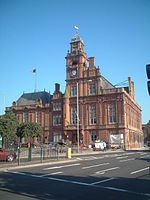Great Yarmouth
| Great Yarmouth | ||
|---|---|---|
| Great Yarmouth Town Hall | ||
| Coordinates | 52 ° 36 ′ N , 1 ° 44 ′ E | |
|
|
||
| Residents | 47,288 (as of 2010) | |
| surface | 26.54 km² (10.25 mi² ) | |
| Population density: | 1782 inhabitants per km² | |
| administration | ||
| Post town | GREAT YARMOUTH | |
| ZIP code section | NR30 (north) NR31 (south) |
|
| prefix | 01493 | |
| Part of the country | England | |
| region | East of England | |
| Shire county | Norfolk | |
| District | Great Yarmouth | |
| British Parliament | Great Yarmouth | |
| Website: www.great-yarmouth.gov.uk | ||
Great Yarmouth is the easternmost town in the county of Norfolk in Great Britain and lies on the North Sea .
The city is the administrative seat of the borough of the same name . Yarmouth used to be an important center of the herring fishery , today the inhabitants live mainly from the oil industry in the North Sea. In addition, the city has been a popular seaside resort since 1760 with a good sandy beach and a long fun promenade. Inland is The Broads National Park , which is ideal for boat tours on the waterways.
history
Great Yarmouth was founded near the Roman garrison of Gariannonum . In the immediate vicinity are the remains of two Roman forts : Garrianonum ( Burgh Castle ) with a well-preserved surrounding wall and Caister-on-Sea , of which only the foundation walls can be seen. Under Elizabeth I , the city was heavily secured .
On May 2, 1845, the city experienced a tragic bridge collapse. Many onlookers wanted to see a circus clown who let four real geese pull him along the river in a washtub. As he passed under the Chain Bridge , the probably more than four hundred people on the bridge moved to the other side. As a result of the shift in weight, one of the chain links broke, the bridge deck tilted and hurled the audience on the bridge into the river. 79 people drowned or were killed by the falling parts of the bridge.
During World War I , Great Yarmouth was shelled by German battlecruisers on November 3, 1914. The city was one of the two targets of the first German airship attack on England on January 19, 1915. The Zeppelin L3 dropped ten bombs on the city, killing two people. Another sea attack, the bombardment of Lowestoft and Great Yarmouth on April 25, 1916, caused only minor damage in Great Yarmouth.
Economy and Infrastructure
In 2002, the Great Yarmouth Power gas and steam turbine power station went into operation in Norfolk . The plant has an output of 420 megawatts and is one of the most modern power plants in Great Britain. In 2005, RWE npower acquired Great Yarmouth Power Ltd, which among other things operates the power plant. Two miles east of the beach is the Scroby Sands offshore wind farm , which was completed in 2005 and has thirty wind turbines with a nominal output of 2 MW each and a rotor diameter of 80 meters. Its annual standard energy capacity corresponds to the annual electricity consumption of approx. 41,000 households.
The establishment of a regular ferry connection to the Dutch IJmuiden (province of Noord-Holland) is planned for the future , from which the city and region expect positive economic effects on the hinterland as well.
In 2007 Great Yarmouth was selected as the location for one of nine licensed British major casinos to be built in addition to the "Supercasino" in Manchester.
The city of Rambouillet in France is twin town of Great Yarmouth.
Personalities
- James Paget (1814-1899), medical doctor
- Anna Sewell (1820–1878), writer, creator of Black Beauty
- Vernon Kell (1873–1942), founder and first director general of MI5
- Jack Cardiff (1914–2009), cameraman and film director
- Ken Colyer (1928–1988), jazz and skifflemusic
- Mike MacDowel (1932-2016), racing car driver
- Matthew Macfadyen (born 1974), actor
- Calvin Goldspink (* 1989), actor and singer
Web links
Individual evidence
- ^ RJ Wyatt: Death from the Skies. The Zeppelin Raids over Norfolk 19 January 1915 . Gliddon Books, Norwich 1990. ISBN 0-947893-17-2
- ↑ RWE npower acquires Great Yarmouth Power Ltd , accessed on May 30, 2011

